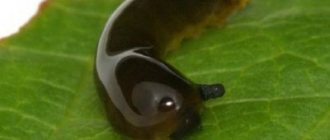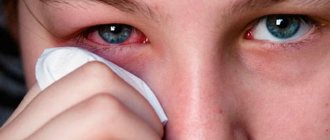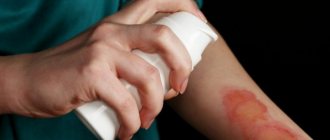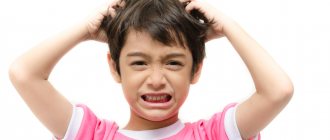Today, a young mother is required to be thoroughly knowledgeable in any issue related to the baby’s health. A typical example: what does a mother usually hear when her child’s eye is watering? “Rinse with sleeping tea, and everything will go away,” “Drip with albucid.” However, first of all, the mother must carefully examine the baby, remember what preceded the appearance of tears, listen to herself, and then decide what to do. Because the reasons for the appearance of tears can be very different: some require treatment, others pass without a certain age, others only indicate problems without requiring direct treatment for lacrimation.
A child has a watery eye and a runny nose: treatment and causes
During a cold, a person experiences symptoms such as cough, runny nose, fever, watery eyes, general weakness and malaise. Many people know methods of treating such colds. It will not be difficult for anyone to soften a cough, reduce pain in the throat or get rid of a runny nose using well-known pharmaceuticals or traditional medicine. But tearing of the eyes always remains an open question and often worries patients. Adults mostly attribute this to the consequences of a runny nose or some kind of allergic reaction that will go away on its own. And, in principle, they are right, which cannot be said about the tearing of a child’s eyes, which can be a symptom of a serious illness.
Reason to see a doctor
If the cause of lacrimation is the entry of a foreign body (eyelash, speck of dust), then you can provide first aid to the baby at home and completely get rid of the disease. The reason for urgently contacting a doctor is the following changes in the functionality of the child’s body:
- If the eye (both eyes) waters for more than 2 days in a row.
- There is itching of the eyes.
- Frequent sneezing appears.
- Purulent contents form in the eyes.
- The baby is suffering from a severe headache.
- Body temperature rises to a high level (above 38.5 degrees).
The manifestation of even one of all of the above signs indicates the addition of a serious infection or other disease process, and only a doctor can determine an accurate diagnosis.
Particular attention should be paid to changes in the functionality of the visual organ in infants. Very often, watery eyes are a symptom of pathological processes, the timely treatment of which will help to avoid troubles in the future.
Causes of watery eyes in children
Infants have watery eyes or both due to damage to the tear ducts due to the following options:
- the nasolacrimal duct may be blocked by the embryonic placenta;
- disruption of the nasolacrimal duct;
- various pathologies of the tracts, canals, eyelids or lacrimal openings;
- the presence of abnormalities in the development of the nose and lacrimal sac;
- mechanical injuries.
If you do not consult an ophthalmologist in time, then with prolonged lacrimation, the microflora of the child’s eyes is disrupted, and an inflammatory process occurs. If a child over one year of age has a watery eye, the reasons may be as follows:
- Canaliculitis (inflammation).
- Diverticula (elongation or change in the shape of the tear ducts).
- Entry of a foreign element (dust, eyelash).
- A tumor (malignant or benign), as well as a cyst.
- Trauma to the canals (for example, during probing).
- Tearfulness with the appearance of pus – conjunctivitis.
- Allergy.
- Change or difference in temperature (from cold to warm and vice versa).
Summarize
The reasons for watery eyes can be very diverse. Our task is to install them on time
. Since we are talking about a situation where a child’s eyes are watery, treatment must be adequate, according to age. We definitely take the child to the doctor in the following situations:
- baby's age up to one year;
- if it does not get better within two days;
- the child has photophobia (he avoids bright light);
- complaints from the baby about pain in the eyes;
- the child began to see worse;
- the presence of a vesicle on the skin of the upper eyelid (may indicate a herpetic infection).
Without neglecting these tips, you will be able to react in time and treat your baby. Let your children grow up healthy!
Author of the article: Goncharova Anna Egorovna
Tears have multiple protective and healing properties. Thanks to this liquid, the eye shell is protected from bacteria, nourishes the cornea so that it does not dry out, but is also characterized by antiseptic properties.
The appearance of tears in a child’s eye always worries young parents, and they immediately go for a consultation with a pediatric specialist. After all, if the eye is watery, these are not necessarily minor reasons; sometimes it is serious and very dangerous for your baby.
It happens that during the course of treatment the eye does not stop watering, and this indicates an incorrect diagnosis.
In such a situation, it is necessary to immediately undergo re-diagnosis.
Tearfulness and runny nose as one symptom
If a child’s eyes are watery and there is a runny nose, this usually indicates a disease from the ARVI group. In the first years of life, even a minor viral infection can lead to a runny nose or even otitis media. This is accompanied by watery eyes or both eyes. There may be complications - inflammation of the auditory tube or mucous sinuses (sinusitis).
A runny nose is called rhinitis. Most often, it occurs in a child in the autumn-winter period due to hypothermia, sudden temperature changes, or even a small draft. Watery eyes and a runny nose as one symptom indicate allergic rhinitis. Appears due to the active flowering of grasses, trees and plants. The temperature does not rise with it, but the child has a stuffy nose and a sore throat.
An infectious runny nose, unlike an allergic one, is accompanied by fever, burning in the nose and subsequently clear discharge from it. In the days following the illness, they become thick and have a greenish color - this is the body’s reaction to the virus.
Barley
Why can stye appear on a child’s eye? As in most other cases, the infection enters the eyes through dirty hands. The baby played in the sand, looked at the pebbles, then rubbed his eyes
.
Staphylococcus aureus is the cause of this disease
.
Although factors such as hypothermia and reduced immunity also play a role
. This disease can even occur in children under one year of age.
Usually the eye looks swollen, the stye swells, and there is pain. On the third day, as a rule, ripening occurs and pus comes out
.
You can try applying a compress with chamomile locally. Antibacterial drops and ointments are also used, taking into account the degree of the disease and the age of the child
. Before applying the ointment, it is important for the mother to thoroughly wash her hands and cut her nails short.
IT IS FORBIDDEN:
- squeeze out the barley yourself;
- self-medicate if the child does not feel better within 2-3 days;
- hesitate to go to the doctor if the baby is less than a year old;
- warm the eye area with egg, salt and other similar methods.
Remember, the principle of mothers, like doctors, is to do no harm!
Diagnosis and treatment methods
As mentioned above, if a child has a watery eye, you should immediately consult an ophthalmologist. He examines the condition of the apple, eyelid and lacrimal openings. For a more accurate analysis, a nasal and canalicular sample is taken, an x-ray of the lacrimal ducts is taken, and they are sent for endoscopy to clean and rinse the canals. If at the end of all studies and tests complications are detected, the therapist writes out a referral for a tomography of the child’s head. Having made a final diagnosis, the doctor prescribes drug treatment or surgery for abnormalities or tumor detection.
If your child becomes infected with ARVI, you should immediately contact your pediatrician and follow his instructions. All treatment procedures, if the disease is not advanced, can be carried out at home. Make a solution of two pinches of salt in a glass of boiled water and rinse the child’s nose to get rid of dried mucus on the walls, which interferes with the normal effects of medications and breathing.
Also brew a decoction of St. John's wort and marigold (calendula) for rinsing, which has an anti-inflammatory effect. You need to let the mixture sit for twenty minutes and instill two or three drops at a time. Warming is considered one of the effective remedies when a runny nose progresses. Use heated salt in a towel or special bags and hold it on the bridge of the child's nose for about 15 minutes.
To prevent mucus stagnation and improve blood circulation, gently massage your cheeks, areas around the nose, and the distance from the temples to the neck with your fingers. To prevent your child from having a runny nose at night, make inhalations of aromatic herbs (chamomile, mint, eucalyptus).
Source
Diagnostics
If the eye is constantly watering, then no matter how old the child is, a doctor must conduct an examination. This is necessary to exclude serious diseases and possible complications.
Depending on the patient’s condition, it is possible to carry out the following diagnostic measures:
- Visual inspection of the eyelids, position of the costal margin and lacrimal canal.
- If necessary, use a slit lamp for biomicroscopy to confirm the diagnosis.
- Conducts a sample from the nose and lacrimal ducts.
- Examination using an endoscope. To do this, the tear ducts will be washed and probed.
- X-ray of tear ducts.
- In case of severe complications, an MRI of the head may be prescribed.
Causes of lacrimation and runny nose in children
Having discovered these signs in a child, take seriously the establishment of the cause of their manifestation. These symptoms may be a consequence of the disease or occur under environmental influences. What to do if you have a severe runny nose and sneezing is described in this material. Possible reasons may be:
- Allergic reaction;
- Teething;
- Hypothermia, overheating;
- Living conditions (dusty, very dry or humid air);
- Respiratory infection;
- Conjunctivitis;
- Sinusitis;
- Obstruction of the lacrimal canal.
Possible diseases
Allergy
Allergies often cause reactions such as runny nose and watery eyes. Breastfed infants are most at risk. Heredity influences whether parents have allergies or not, living conditions, and contact with animals. Allergens can be:
- Food;
- Household;
- Medicinal;
- Biological (plants, insects, fungi, bacteria, parasites);
An allergic reaction in a baby often results in redness around the eyes. The skin is itchy, irritated, and the child constantly touches and scratches the problem area. In addition to irritation of the mucous membranes of the eyes and runny nose, sneezing is added. Some allergic reactions are seasonal.
Teething
Teething is accompanied by mucus discharge from the nose . Almost all mothers face this. When teeth are cut, the blood supply to the gums and nasal cavity is activated (they are interconnected). As a result, the mucous membrane is activated and clear mucus is released from the nose in small quantities. Tearing usually accompanies the appearance of the upper canines. If this is not accompanied by a high temperature, the runny nose is not severe and your breathing is calm, then there is nothing to worry about. All this will pass with the appearance of the tooth. The best children's drops for runny nose are presented at the link.
Teething helps reduce local immunity. The likelihood of infection increases. Be attentive to your child's health during this time.
Conjunctivitis
Conjunctivitis is an inflammation of the conjunctiva, the membrane lining the top layer of the eye and eyelid. It is accompanied by a flow of tears from the eyes, after sleep there is pus, the eyelids swell. Due to the fact that the tear ducts are connected to the nose, lacrimation is accompanied by “squelching” of the nose.
This disease has three forms:
- Viral;
- Bacterial (acute);
- Allergic.
An ophthalmologist determines the form of conjunctivitis and prescribes appropriate treatment.
Obstruction of the lacrimal duct
Tear duct obstruction occurs in 5% of infants. The symptoms are similar to those of conjunctivitis, treat it first. And, if the treatment does not help, brings only a temporary effect, consider the possibility of canal obstruction. They cope with this disease with the help of probing. The procedure is unpleasant, to say the least, but lasts only a few minutes.
A cold can also cause these eye and nose symptoms. There are many medications that can help relieve nasal pain during the treatment of respiratory infections. The main thing here is to treat the disease itself and the symptoms will go away on their own. Folk remedies for the common cold are presented here.
Sinusitis
Sinusitis is an inflammation of the paranasal sinuses. Accompanied by fever, sneezing, sore throat, inflammation of the nasal mucosa and swelling. In this case, the nasal septum swells and creates unpleasant sensations around the eye sockets and cheekbones.
Treatment
Do not use medications for older children in the treatment of infants. Contact your pediatrician, he will prescribe the best possible set of medications for treatment.
By medication
- If you have purulent conjunctivitis, you need to wash your eyes Before going to the ophthalmologist, you can put Tetracycline eye ointment behind the lower eyelid. Apply it 3 – 5 times a day. Or instill Levomecithin drops. They can be used to treat babies from 4 months.
- If you are teething, to relieve itching in the gums, use gels with an anesthetic effect, they are sold in pharmacies (Kalgel, Dentinox). Remove mucus from the nose with an aspirator.
- If the lacrimal canal is obstructed, massage is prescribed. If it does not help, probing is carried out. The procedure takes place in a medical office using local anesthesia. A probe is inserted into the nasolacrimal canal, which pierces the embryonic film. The canal is washed with a disinfectant solution. The procedure lasts several minutes. After this procedure, a repeat series of massages is performed to avoid relapse and prevent adhesions in the tear duct.
- Nazivin (a vasoconstrictor) can be used for nasal instillation From 5-6 months the following products are suitable: Otrivin, Xylene, Vibrocil. From 7 months, use interferon. It is used both in treatment and as prevention.
How to cure symptoms using traditional medicine
So, you've looked at all the options, found the cause, and tomorrow you'll go to the doctor. How can you help your child before seeing a specialist?
Eye wash
- Rinse your eyes with brewed strong black tea, chamomile or calendula infusions. To do this, wet a cotton pad and move it towards your nose. Carry out the procedure about 4 – 6 times a day. Make sure that between procedures the baby does not touch his eyes with his hands.
- If your eyes are watering due to allergies, rinse your eyes with saline solution and apply antihistamine drops.
If you are cutting teeth
A massage of the gums and a compress with chamomile infusion will help ease the condition of the little one. Silicone teethers are also used.
How to help?
It is important to identify the disease in a timely manner and correctly follow all the doctor’s instructions, so as not only to quickly cure, but also not to cause further harm:
- Do not deviate from the doctor’s recommendations and do not self-medicate in difficult situations.
- During treatment, do not allow the child to look at bright lights for a long time or expose them to harmful types of radiation.
- Follow eye care recommendations.
- If the cause of lacrimation is an allergy, do not allow the child to come into contact with the allergen.
In order not to harm the child, it is better to:
- Carry out medical procedures or examinations with dirty hands.
- Respond to the child’s complaints, do not trigger the disease.
- Do not independently replace or cancel medications prescribed by a specialist.
- React not only to lacrimation, but also to the cause of their appearance: infectious infection,
- elimination of allergens,
- foreign object entry
- the presence of neoplasms in the eye.
Massage of the tear duct
Sometimes massage of the tear duct is the only way to get rid of unpleasant symptoms. Before performing a massage, it is worth clarifying the cause of tearing of the eye.
Features of lacrimal canal massage:
- Do massage only with clean hands.
- In case of dacryocystitis, massage of the lacrimal canal is one of the most effective methods of treatment and prevention. It not only relieves symptoms, but also prevents such manifestations as yellowish and purulent discharge from the eyes.
- Massage consists of vibrating movements that are performed carefully.
- During the massage, you need to lightly press on the tear duct of the eye.
- This procedure requires compliance with the correct direction of massage activities. Movements should be carried out from the outer to the lower corner.
- If there is purulent discharge during the massage, it is carefully removed with a cotton swab.
Improvement and rapid recovery will come if you carry out the procedures regularly and follow all recommendations for massage.
Prevention
To prevent unwanted symptoms, you can do the following:
- Strengthen the baby’s immunity (hardening, proper daily and nutritional regimen, walks);
- Avoid child contact with suspected allergens, maintain a favorable microclimate, and carry out wet treatment of housing more often;
- Avoid contact with sick people and do not appear in public places during an epidemic outbreak;
- Prevent overheating and hypothermia of the child;
- During the cold season, include fruits and vitamins in your child’s diet.
How to treat dry cough during pregnancy - you will find the answers here.
Why does a child's eyes water and snot flow?
In childhood, a runny nose accompanied by sneezing and lacrimation is a common occurrence. This is due, first of all, to the anatomical structure of the body and the fact that the child’s immune system is not yet strong. Irritation and inflammation of the nasal mucosa occurs for various reasons. If a child has watery eyes and a runny nose, then there is a need to visit a pediatrician who, if necessary, will conduct diagnostics and prescribe drug therapy.
Dacryocystitis of a newborn
If a newborn's eye is watery, we pay special attention to this. Why? — Infants are at risk of a disease called dacryocystitis in medical practice. In the tear-nasal canal of an unborn baby there is a special thin film that breaks at birth and the first cry
.
This opens a channel through which tears flow, thereby washing the eyeball, cleansing it, and protecting it from pathogenic infections. However, this does not happen in 5-7% of children
. Then stagnation of tears occurs, and, as a result, bacteria multiply well in such an environment.
The symptoms of dacryocystitis are very similar to conjunctivitis: the child’s eye also becomes watery, red, and may discharge pus. The difference is that only one eye is affected.
Treatment tips are very similar to the previous ones. First of all, consult a doctor. It will help make the correct diagnosis
.
To relieve inflammation, the doctor may prescribe Ophthalmodek or Albucid drops, washing the eyes with a warm chamomile decoction, which is especially important in the morning. And most importantly, the doctor will show you how to properly massage for this disease
. This procedure is fundamentally important for recovery.
The massage technique is something like this: gently and carefully, with vibrating movements, you should press on the tear-nasal canal. The direction should be from top to bottom in the inner corner
.
The movement feels as if you are pushing something out. During the procedure, remove the released pus with a clean, damp cotton swab
. Needless to say, hands should be thoroughly washed before a massage!
If all of the above has not given the desired results within two weeks, the doctor prescribes sounding. This is an operation under local anesthesia
. Almost always it goes well, without any complications.
Reasons for development
If a child has watery eyes and snot, what could be causing these symptoms? Among the most common reasons are:
- Allergic reaction. If you have an allergy, one or both eyes may become watery. Those children who are bottle-fed are more susceptible to developing such symptoms than others. The cause of allergies is not only allergens, but also heredity.
- Respiratory infection. Red eyes and snot can occur in children with colds caused by various viruses. Infection occurs through household or airborne transmission. The risks of contracting a respiratory infection increase during the cold season.
- Unacceptable microclimate. Dry air and high indoor temperatures are the main enemies. For young children, such a microclimate is dangerous and can cause nasal discharge, redness of the mucous membranes and conjunctiva.
- Teething. When a child’s teeth come out, they experience not only increased drooling, but also a runny nose. In this case, discharge from the eyes may appear. This is due to the fact that against the background of the eruption of baby teeth, a sharp decrease in immunity occurs, which is fraught with the development of frequent colds.
Predisposing factors against which a child may have watery eyes and a runny nose as a constant companion are the presence of a block in the area of the nasolacrimal duct and anomalies in its structure. Defects in the structure of the lacrimal sacs and the anatomical features of the nasal septum should not be overlooked. Mechanical damage is a risk factor.
Sinusitis
With a runny nose, as a rule, lacrimation does not occur if we are talking about rhinitis. In cases where timely treatment is not provided, complications develop in the form of sinusitis. As a result of the inflammatory reaction, pathogenic microorganisms penetrate into the area of the paranasal sinuses. This is accompanied by increased production of mucus that accumulates in the sinuses. Acidification and progression of the inflammatory process occurs.
If untreated, the discharge becomes purulent, which is accompanied by the appearance of pain and hyperemia. Swelling in the area of soft tissues leads to the fact that the outflow of tear fluid becomes difficult and begins to flow out of the eyes. The child develops increased lacrimation, the voice becomes nasal, and nasal breathing becomes difficult. Green snot flows from the nasal passages, which has a fairly thick consistency.
ARVI and influenza
After the virus enters the child’s body, there is a rapid increase in the number of pathogenic microorganisms, which is accompanied by the production of a large amount of toxic substances. Common viruses include adeno- and rhinoviruses, as well as respiratory syncytial infection.
Possible reasons
The sooner you find the cause of your baby's excessive tear production, the sooner you can deal with this problem. It is worth remembering that correct and effective treatment largely depends on the causes of its occurrence.
. Let's look at what the reasons are: ̉
- An abnormality of the lacrimal can be one of the main causes. These factors include lengthening of the canals, changes in their shape, inflammation or protrusion of the canals.
- A child’s eye may also become watery if a foreign body has entered it and interferes with the normal functioning of the eye (dirt, dust, eyelash, speck, etc.).
- Cyst, malignant/benign tumors (polyps, basal cell carcinomas, squamous cell carcinoma).
- Trauma to the eye, which leads to damage to the canals. Such injuries can lead to changes in the canals (narrowing and subsequent overgrowth)
. This may occur due to improper rinsing of the eye, if there have been repeated preventive or therapeutic procedures. - If there is also purulence in the eye, this may indicate diseases: conjunctivitis (consequences of a cold or flu), keratitis, inflammation of the nose, blepharitis.
- Redness and tearing during sneezing is an allergic reaction; perhaps the child is allergic to some product or thing. May be accompanied by itchy eyes.
- If there is tearing in one eye, this sometimes becomes an indicator of nervous system pathology.
- Temperature changes can cause a defensive reaction, which is accompanied by tears. Under normal conditions such reactions do not occur
. This reaction is not a pathology and does not require treatment.
Establishing diagnosis
To determine the cause of a runny nose and watery eyes, it is imperative to consult a pediatrician, otolaryngologist or ophthalmologist. The specialist will first analyze the external state of the conjunctiva and mucous membranes, take a nasal and tubular sample.
A test is required that uses collargol (3% concentration). The drug is intended for diagnosing eye conditions. It is instilled onto the conjunctiva, and after 5 minutes it comes out through the nasal passages. If the medicine does not flow down, then there is a violation of the patency of the lacrimal canal in one or both eyes.
If such a need arises, the doctor prescribes a special endoscopic examination. It is mandatory to wash the tear ducts, which improves visibility during diagnostics.
Treatment measures
The tactics of drug therapy depend on the cause of watery eyes and a runny nose:
- With an allergic factor, contact with the allergen is excluded. Procedures for rinsing the nasal passages using Dolphin or Aqualor are prescribed. The patient is prescribed an anti-allergenic diet and, if necessary, antihistamines such as Allergodil or Suprastin are prescribed. In advanced cases, hormonal treatment with Nasonex cannot be avoided.
- For infectious rhinitis and conjunctivitis, antiviral and antibacterial nasal drops are prescribed: Bioparox and Nazoferon. To relieve symptoms, you can use vasoconstrictors such as Vibrocil and Tizin. To treat the eyes, antibacterial drops Tetracycline and Albucid, and antiviral agents are prescribed: Actipol. The nose is washed with a solution of sea salt or the drug Humer.
When teething, no additional measures are required to correct a runny nose and watery eyes. If the symptoms are pronounced, then you can use vasoconstrictor nasal drops.
When treating lacrimation and runny nose in children, it is necessary to carry out a comprehensive diagnosis in order to correctly determine the cause of these symptoms. If uncontrolled drug therapy is carried out, there is a high risk of complications as symptoms progress. When primary signs appear, it is recommended to go to the doctor. The sooner treatment is carried out, the greater the chances of a complete recovery and eliminating the likelihood of relapses.
Source
Doctors' recommendations
Ophthalmologists have developed general recommendations that will help avoid complications of eye diseases and correctly carry out medical procedures:
- Mothers should be careful about what cosmetic products they use on their child's skin and be aware of the possible negative effects on the skin. It's sad, but often even the most advertised children's cosmetic brands contain substances that are considered harmful not only to children, but also to adults. You need to carefully choose children's shampoos, gels, and creams. They must be hypoallergenic and safe. The shelf life of a quality product should not exceed more than 10 months.
- Parents should be attentive and thoroughly inquire about all complaints or ailments of their children.
- Do not put off visiting an ophthalmologist or treatment for a long period. This will cause serious complications.
- Pays attention to the prescribed therapy and does not deviate from the doctor’s prescriptions.
- Do not self-medicate , do not perform procedures with dirty hands or non-sterile objects.
- If you suspect a tumor in the eye, consult a doctor immediately.
- Use traditional medicine with caution for primary therapy and preventive measures with eyes when they are watery.











